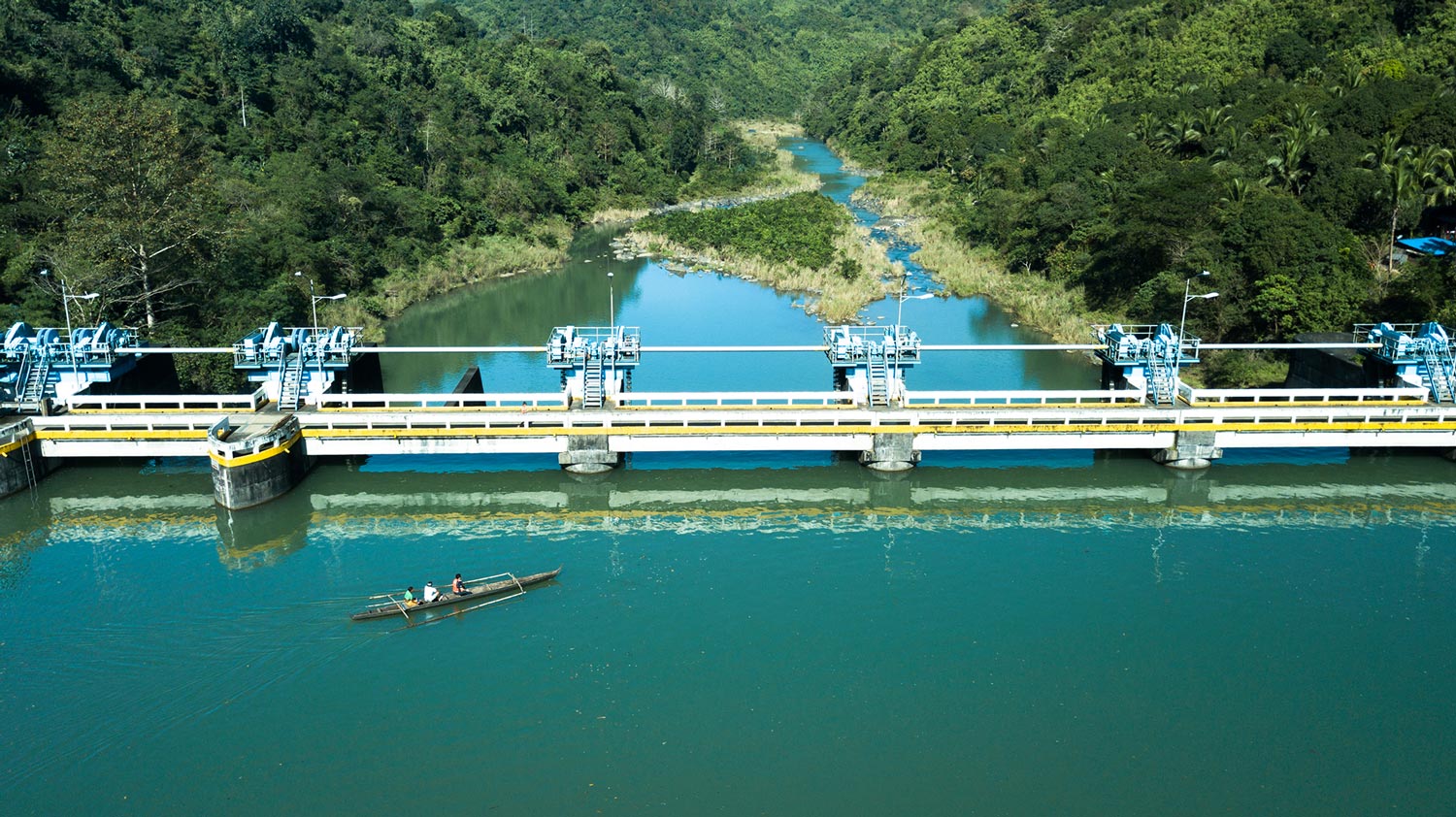
The Ipo watershed is part of the Umiray-Angat-Ipo-La Mesa water resource system which provides raw water to Metro Manila.
Manila Water, being a water utility company, has a critical role in ensuring that the ecosystem it relies on is protected and restored. Without adequate and good quality water, the sustainability of its business is at risk, compromising its ability to provide reliable and 24/7 water supply. The Company implements environmental management across its value chain including watershed protection and rehabilitation, wastewater treatment, operational efficiency, carbon reduction and methane avoidance, and circularity.
Managing Water Resources
GRI 2018 303-1, 303-3; SASB IF-WU-440a.1, IF-WU-440a.2, IF-WU-440a.3.
Commitment:
Take a proactive role in the development, protection, rehabilitation, and enhancement of water sources including watersheds, surface, and groundwater resources
Strategies and Performance:
Sustainable Water Abstraction
Manila Water sources 88% of raw water from surface water and 12% from groundwater. One hundred percent are freshwater, and no raw water was abstracted from high to extremely high baseline water stress region based on the WRI Aqueduct tool. The Company recovered and reused 1.083 million cubic meter (mcm) of backwash water to add to the production of potable water.
East Zone, the largest user of water, abstracts 99% of its raw water from Umiray, Angat, Ipo, La Mesa Manila Water System, and Laguna Lake, and only 1% comes from groundwater. Groundwater sources are intended to be an interim source only to meet the immediate water supply requirements while the new surface water projects are still being developed. By 2025, Manila Water will have additional raw water from Upper Marikina and Kaliwa Watersheds, and Laguna Lake.
Non-East Zone business units (BUs) in Boracay, Calbayog, Cebu, Laguna, Tagum, and Vietnam source raw water from surface water. For BUs that draw from aquifers due to the unavailability of surface water sources in their respective areas, Manila Water ensures that extractions comply with the guidelines and limits of water permits granted by the National Water Resources Board.
The recent groundwater studies conducted in the East Zone, Laguna Water, and Clark Water showed that abstractions are still at a sustainable level at the rate of abstraction. Furthermore, some BUs have medium to long-term plans to eventually source from surface water either through bulk water contracts or through developing their new water sources.
Clark Water has conducted feasibility studies in Sacobia, Marimla, and Bamban Rivers to explore surface water sources for the medium and long-term water requirements of the Clark Freeport Zone. Similarly, Bulakan Water has decommissioned four deep wells that it has taken over from the water district and begun to source raw water from the Bulacan Bulk Water Supply Project which provides surface water from the Angat Reservoir.
Manila Water's public-private partnership with the Provincial Government of Pangasinan on the 25- year Pangasinan Bulk Water Project will source water from Agno River using Riverbank Filtration technology. It will increase the water supply of the province, providing 200 million liters per day to at least 14 cities and municipalities in the province.
Water Withdrawal by Source (in mcm)
|
2019 |
2020 |
2021 |
|
Groundwater
|
92.98
|
109.96
|
112.24
|
|
Surface Water
|
746.03
|
786.71
|
788.57
|
|
Bulk Water or Third-Party Water
|
4.63
|
5.36
|
5.03
|
|
Groundwater
|
0.19
|
0.27
|
0.34
|
|
Surface Water
|
4.44
|
5.08
|
4.68
|
|
Total
|
843.64
|
902.03
|
905.83
|

87% from surface water

12% from groundwater

1% from bulk water or
third-party (surface water)

100% freshwater source

0% water abstracted from high to extremely high baseline water stress

1.083 mcm of backwash water recovered and reused
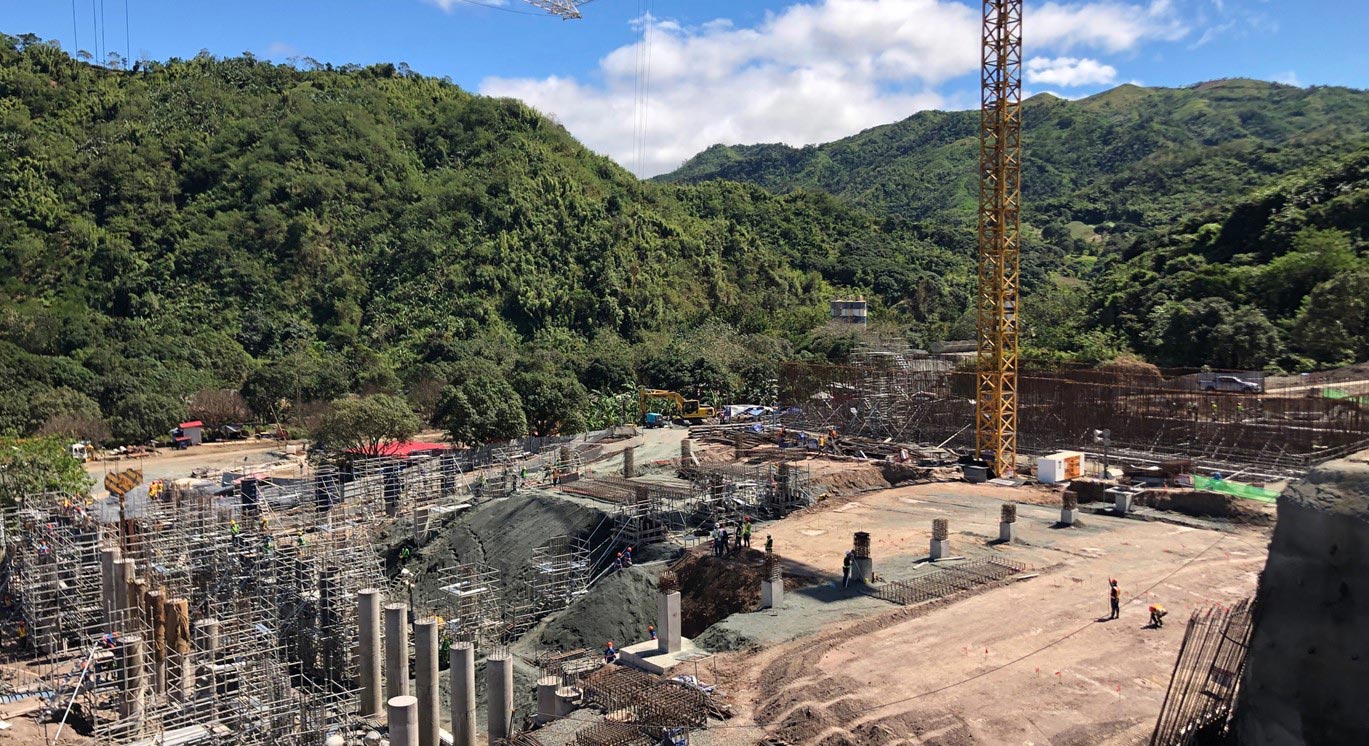
The Wawa-Calawis Water Treatment Plant will provide additional 80 MLD water supply for the East Zone.
Watershed Management
GRI 304-3, SASB IF-WU-440a.3
Manila Water anchors its management of key watersheds on partnerships, integrated approach, nature-based solutions, and environmental stewardship to mitigate the risks of deforestation and deterioration of raw water quality. This strategy also improves biodiversity and contributes to carbon sequestration to mitigate climate change.
Manila Water helps in the protection of 171,901 hectares in General Nakar, Ipo, La Mesa, Nabaoy, Pan-as Hayiban, Villa Maria watersheds. For its reforestation initiatives, the Company planted 62,823 native trees in 2021 reaching a total of 1,255,612 trees nurtured since 2006.
Manila Water also helped in the formulation of the Integrated Watershed Management Plan (IWMP) of General Nakar, La Mesa, and Upper Marikina watersheds. The Company will help in the development of an IWMP for Ipo to support the existing Ipo Watershed Management Framework Plan. Cebu Water in cooperation with Cebu Metropolitan Water Foundation is crafting the IWMP of Luyang Watershed.
East Zone through its implementing partners in La Mesa, Upper Marikina, and General Nakar watersheds planted 60,313 native trees in 2021. Trees planted in previous years were maintained and nurtured. The Company has been supporting the Annual Million Trees Challenge (AMTC) of the Metropolitan Waterworks and Sewerage System since the start of this program in 2017. For 2021, Manila Water’s contribution to the AMTC is 40,000 trees planted in La Mesa Watershed for a total of 386,000 trees in La Mesa and Upper Marikina Watersheds since 2017.
The Company provides funds for the continuing protection of Ipo and La Mesa watersheds through the Bantay Gubat composed of Dumagats, and the ABS CBN Foundation’s Bantay Kalikasan, respectively. Manila Water also supports the General Nakar Sustainable Integrated Area Development Project in General Nakar for the protection of the entire watersheds of Kaliwan, Kanan, Umiray and 13 minor watersheds through the patrolling of Bantay Gubat.
Manila Water will commission Forest Carbon Accounting in Ipo, La Mesa, and Upper Marikina Watersheds to determine the baseline of carbon sequestration and the carbon uptake of the trees planted in these watersheds. This will quantify the impact of the Company’s reforestation and forest protection programs in capturing carbon from the atmosphere.
Manila Water in partnership with the Manila Water Foundation (MWF) is developing a Water Access, Sanitation and Hygiene (WASH) program for the Dumagat and Ipo watershed community. MWF together with Metropolitan Waterworks and Sewerage System (MWSS) and Worldwide Fund (WWF) has already conducted a technical and social assessment. A preliminary design for water supply has been prepared for approval.
Boracay Water adopted 40 hectares in Nabaoy Watershed for protection and reforestation in partnership with the DENR (Department of Environment and Natural Resources), LGU (Local Government Units), and the Nabaoy Forest Farmers Development Association (NAFFDA). This year, Boracay Water planted 885 native trees with seedlings brought from NAFFDA.
In 2021, Calbayog Water partners with the DENR, the Protected Area Management Office, Calbayog City Water District, and the Calbayog LGU for the watershed rehabilitation of Pan-As Hayiban Watershed using rainforestation farming. Calbayog Water targets to plant, nurture and monitor 782 indigenous trees in 1.25 hectares per year through partner communities. The project includes activities on improving the resilience of communities through community empowerment activities, refresher courses on rainforestation technology, and orientation on the Expanded National Integrated Protected Area System. DENR's nominated and deputized forest patrols/rangers will be assigned to conduct intensive forest foot patrol and surveillance. Forest patrol stations will also be established. Capacity building on rainforestation technology, learning sessions in leadership, financial management, and community organizing will be conducted for the partner agencies and community.
Clark Water through its partnership with DENR and Villa Maria Aeta Tribal Association adopted 16 hectares in Villa Maria, Pampanga for the protection and planting of bamboos from 2020 to 2025. This project aims to protect water reserves and provide a livelihood to the communities. The Company planted 1,000 bamboos in 2.75 hectares in 2021.
Watershed Protected and Restored in 2021
| Watershed |
Area protected, ha |
Area Planted, ha |
Trees planted |
|
Ipo
|
6,600
|
0
|
0
|
|
La Mesa
|
2,659
|
100
|
40,000
|
|
General Nakar
|
162,613
|
33
|
20,313
|
|
Nabaoy
|
20
|
0.4
|
885
|
|
Pan-as Hayiban
|
1.25
|
1.25
|
625
|
|
Villa Maria
|
7.75
|
2.75
|
1,000
|
|
Total
|
171,901
|
137
|
62,823
|
2021 Watershed Management projects, partners, stakeholders, and the 2022-2025 action plans per watershed are listed here.

1,255,612 native trees planted and nurtured

171,901 hectares of forest area protected
127 hectares of area reforested

62,823 native trees planted and nurtured

Birds like the Mangrove Blue Flycatcher flourish at the La Mesa Watershed, a major water source and the “green lung” of Metro Manila. (Photo by Jayce Japlit)
Treating Wastewater Responsibly
GRI 303-2, GRI 303-4, SASB IF-WU-140b.1.
After water is used by customers, Manila Water collects and treats wastewater before discharging clean effluent back to the environment. This reduces the pollution of rivers and lakes and avoids the release of methane emissions from septic tanks and untreated wastewater.
Commitment:
- Treat wastewater in accordance with effluent standards
- Expand sewer coverage and/or desludging services in concessions with wastewater services
Strategies and Performance
Sewerage and Sanitation Expansion
Manila Water operates 70 wastewater treatment plants with a total capacity of 530,407 cubic meter (m3)/day across the Philippines. Nineteen of these facilities with a total capacity of 275,802 cubic meter (m3)/day are in medium to high flood zones (0.5 meter to more than 1.5-meter flood level) based on a 100-year flood. Wastewater treatment facilities within these zones are built or retrofitted such that operations will not be affected, or there will be minimal impact during flooding such that normal operations can resume promptly after a short downtime.
In 2021, the East Zone has expanded its sewer coverage to 33.5% equivalent to 2.3 million customers with sewerage access coming from 3% sewer coverage serving 45,000 customers at the start of the concession. The Company desludges septic tanks of unsewered areas every five years. From 2017 to 2021, an equivalent of 5.44 million population in the East Zone was provided with septic tank desludging. There is a regulator-approved wastewater master plan to expand sewer coverage to 99% in the East Zone by 2037 as a commitment to the Supreme Court Continuing Mandamus to clean up Manila Bay.
To add to the existing 41 wastewater treatment facilities in the East Zone, the Company commenced the construction of its Mandaluyong West Sewerage System Project which includes a 53 km network and the Aglipay STP with a 60 million liter per day (MLD) capacity, expandable up to 120 MLD. It will serve 2,115 hectares of catchment area spanning across Mandaluyong, San Juan and Quezon Cities equivalent to 652,000 customers. The construction of the STP is expected to be completed by 2024 and the sewer network by 2025. Other STPs in the pipeline by 2025 are the Hinulugang Taktak STP with 16 MLD capacity and Quezon City East STP with 18 MLD capacity.
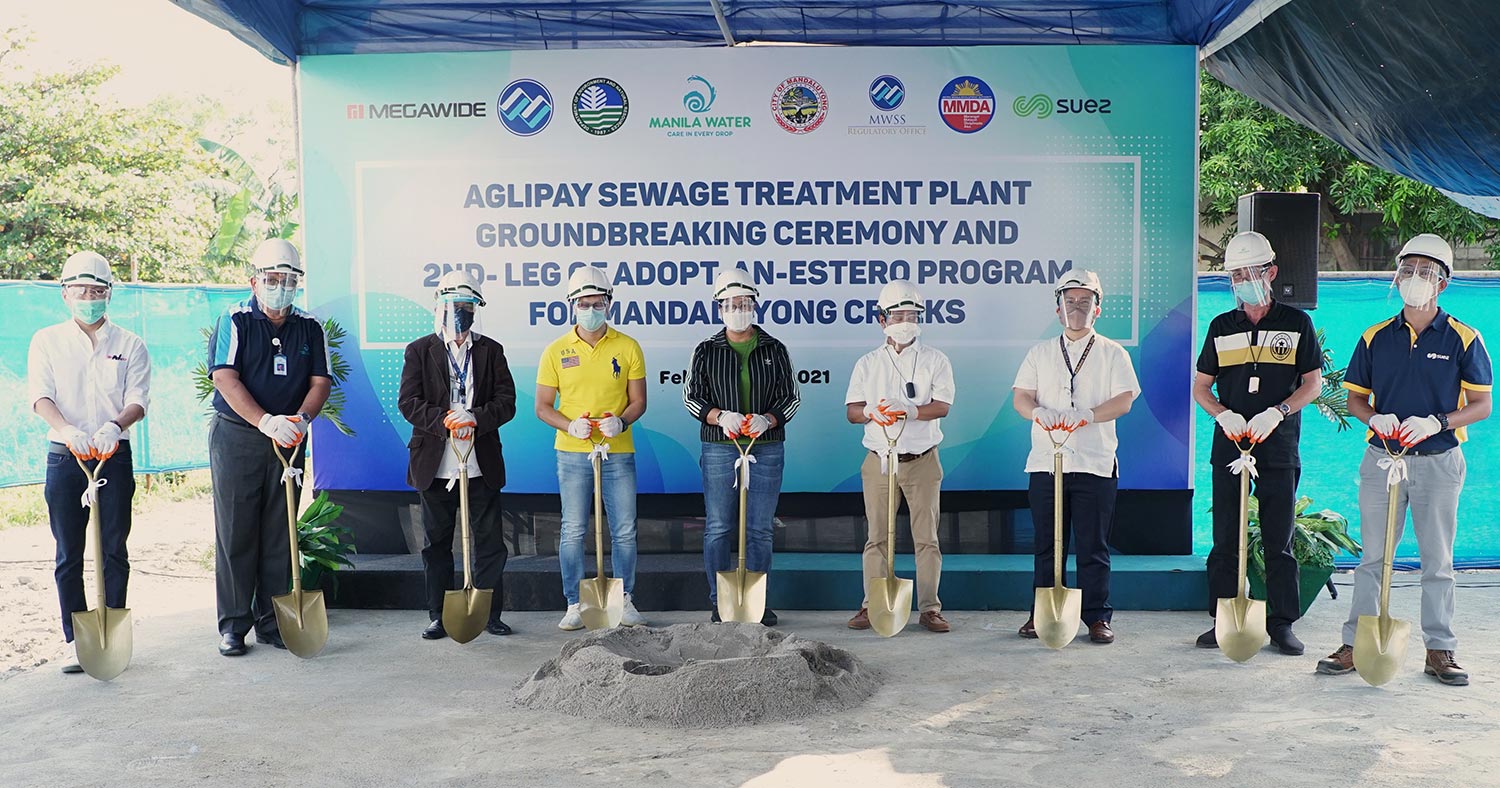
Groundbreaking at Aglipay STP that will treat additional 60 MLD (expandable to 120 MLD) wastewater in the East Zone.
Boracay Water, Clark Water, Estate Water, and Laguna Water also operate their wastewater treatment facilities in their respective service coverage areas. Calbayog Water targets to construct and operate its septage treatment plant by 2025 to start desludging services in Calbayog.
Laguna Water provides desludging services in Sta. Rosa, Cabuyao, and Biñan, Laguna with an expansion in Pagsanjan in 2022. The collected septage is treated in the LTI Septage Treatment Plant. Bulacan Water started its desludging services in 2021 with a third-party service provider while Bulacan Aqua Estates and Obando are in the preparation stage which includes public consultations and refinement of LGU's ordinance on sanitation.
Biological Nutrient Removal
Manila Water complies to the DENR Revised General Effluent Standards of 2016 (DAO 2016-08), the new effluent standard, which requires the removal of nutrients such as nitrogen, potassium, and ammonia in wastewater to reduce the algal growth and further improve the quality of water bodies. The Company implemented operational adjustments and/or upgraded the facilities to meet the effluent standard. The upgrading and retrofitting of the wastewater facilities are in various stages in accordance with the DENR-approved Compliance Action Plan. The Company utilized several state-of-the-art technologies for biological nutrient removal such as Membrane Biological Reactor, Integrated Fixed Film Activated Sludge, Moving Bed Bioreactor, and Food Chain Reactor.
Manila Water continues to comply with the other parameters of the effluent standard and other regulations on wastewater. In 2021, the Company was able to achieve 100% compliance to effluent standards. The details of the effluent quality are in the Environmental Performance Index page.
100% compliance to the effluent standards.
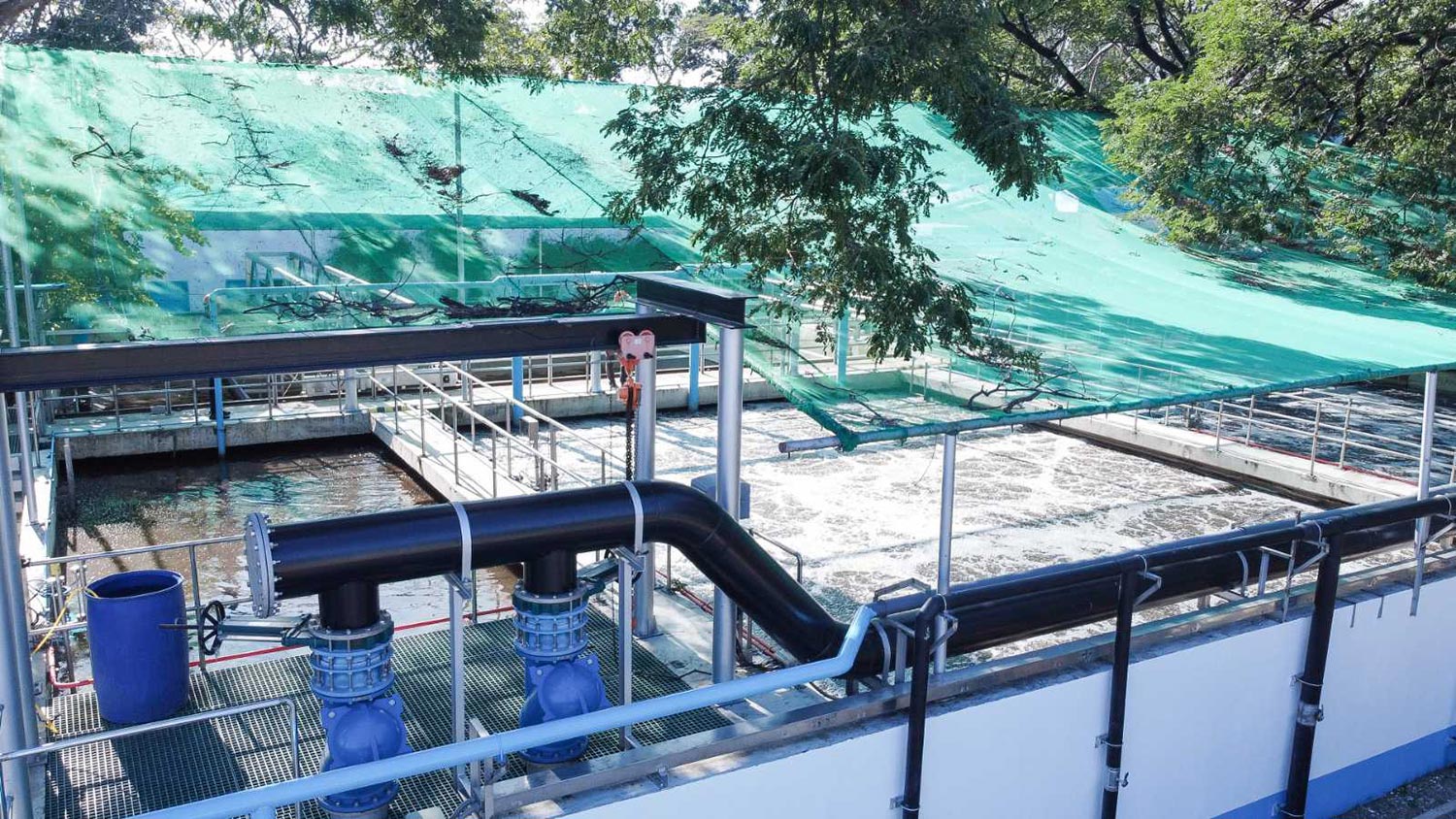
Laguna Water upgraded its sewage treatment plant to remove nutrients from wastewater in compliance to the new effluent standards.
Wastewater Treatment
|
2019 |
2020 |
2021 |
|
Wastewater treated, mcm
|
64.29
|
74.11
|
69.82
|
|
Bio-chemical oxygen demand (BOD) removed1, tons BOD
|
13,525
|
12,613
|
8,795
|
|
Carbon dioxide avoided due to wastewater treatment2, tons CO2e
|
79,586
|
74,285
|
51,814
|
Notes:
- BOD, or biochemical oxygen demand, is a proxy indicator of the quality (or organic content) of the waste. It pertains to the organic component removed from wastewater (in the form of sludge).
- Computation of carbon dioxide avoided was based on the updated 2019 Intergovernmental Panel on Climate Change (IPCC) Guidelines for National Greenhouse Gas Inventories
- Wastewater treated, BOD removed and carbon dioxide avoided decreased in 2021 due to the lockdown and closure of some commercial establishments during the pandemic.
Improving Operational Efficiency
Continual improvement of operational efficiency across the value chain reduces the consumption of finite resources and costs in producing and distributing water and treating wastewater. Improved efficiency also reduces the Company's carbon footprint and impact on the environment.
Commitment:
- Sustain the non-revenue water based on economic level
- Continual improvement through innovations
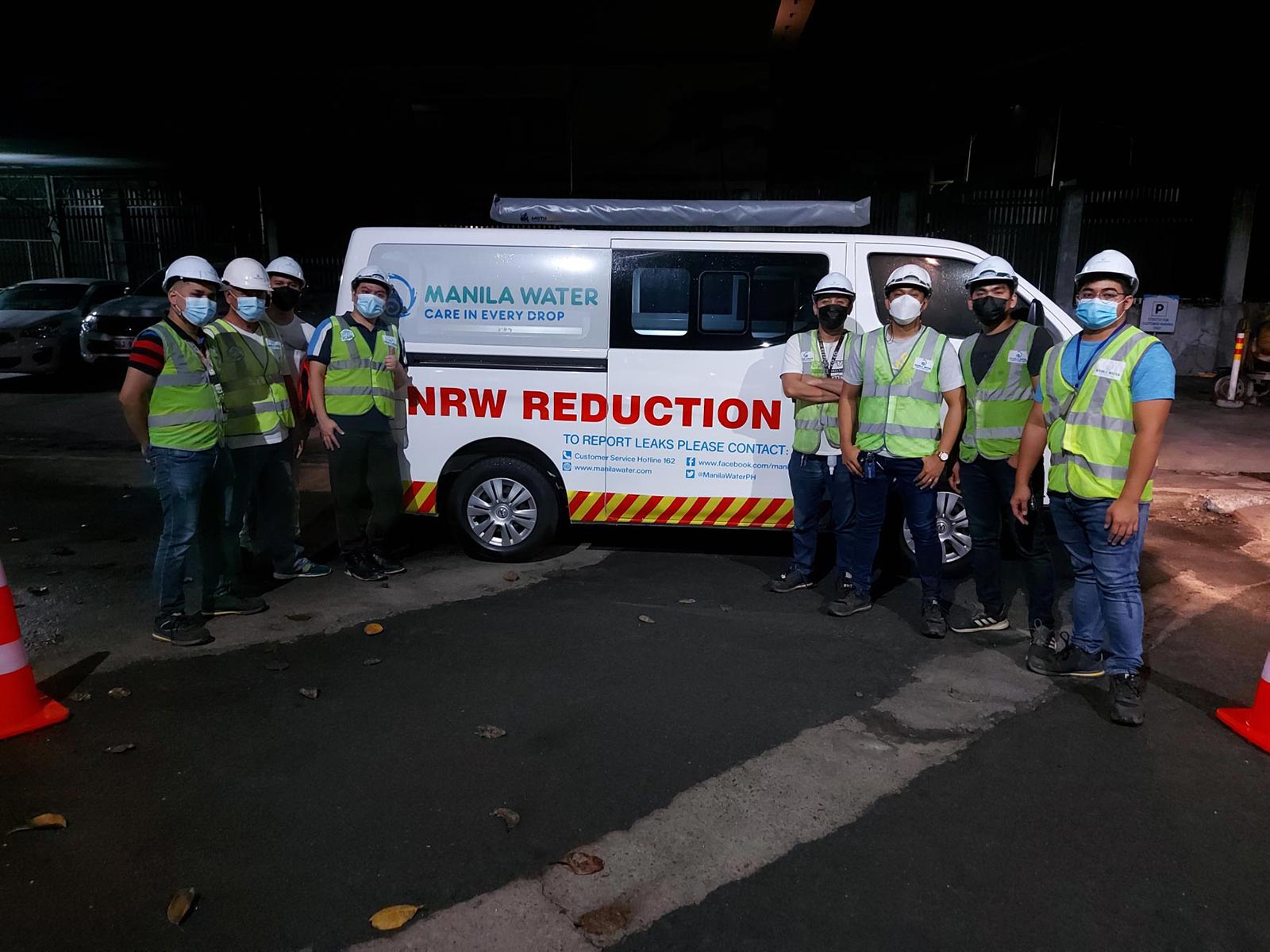
Manila Water continuously implements its NRW reduction program through proactive measures and state-of-the-art technologies.
Strategies and Performance
Non-revenue water (NRW) reduction
The NRW program is implemented across all business units to further reduce the water losses in its water distribution network. The NRW was reduced to 10.2% across the enterprise through pressure management, use of Demand Monitoring Areas (DMAs), active leak control, selective meter replacement. New business units formed Demand Monitoring Areas to easily detect leaks and manage pressures.
East Zone’s lower NRW in 2021 was due to the corporate focus and team effort in increasing leak detection and repair activities, replacing old customer meters, and balancing pressure with demand despite the lockdowns during the pandemic. To manage the risk of increasing NRW, Manila Water installed additional pressure regulating valves with an automated controller to balance the pressure with the demand, especially during off-peak hours.
|
2019 |
2020 |
2021 |
|
End-of period NRW of the enterprise, %
|
8.5%
|
12.2%
|
10.2%
|
|
Non-revenue water losses, MCM
|
69.92
|
104.89
|
112.97
|
The % NRW per Business Unit is in the 2021 Environmental Performance Index
Innovations in Operations
Efficient Use of Chemicals
Water supply’s chemical consumption depends on the quality of the raw water. In 2021, chemical intensity improved due to better raw water from the sources. On top of the improved chemical intensity, Manila Water still seeks to optimize its processes. For instance, instead of purchasing, Laguna Water produces its own sodium hypochlorite.
For medium to long-term solutions, Manila Water strengthens its watershed protection and rehabilitation to prevent soil erosion and water turbidity during heavy rainfall and strong typhoons.
Chemical Consumption, tons
|
2019 |
2020 |
2021 |
|
Water Supply
|
97,072
|
26,736
|
18,346
|
|
Wastewater
|
2,379
|
2,659
|
5,670
|
|
Total
|
99,451
|
29,395
|
24,015
|
Chemical Consumption Intensity
|
2019 |
2020 |
2021 |
|
Water Supply, tons/MCM raw water abstracted
|
115.1
|
29.6
|
20.3
|
|
Wastewater, tons/MCM treated
|
37.0
|
35.9
|
81.2
|
On the other hand, there’s a spike in chemical consumption in wastewater due to
the new effluent standard that requires the removal of nutrients in wastewater.
Additional and new chemicals were used to remove phosphorus through
chemical precipitation.
Energy Efficiency
GRI 302-1, 302-3, 302-4, 305-1, 305-2, 305-3, SASB IF-WU-130a.1.
Water supply and wastewater operations are energy-intensive, making energy one of the highest operating expenses of Manila Water. The Company continuously innovates to further improve energy efficiency in its operations.
Business units undertake process improvements such as proper scheduling of operations, use of the appropriate size of pumps and blowers, adjustment of variable frequency drives to flow, refilling of tanks through gravity flow. Other innovations to improve energy efficiency are the replacement of pumps, motors, and blowers with more efficient technology, deep well rehabilitation, and the continuous NRW reduction program. This brought about savings of about 9.5 million kWh equivalent to PhP 75 million saved in 2021. The water supply energy intensity improved meanwhile the wastewater energy intensity increased due to the additional processes of nutrient removal required by the new effluent standard.
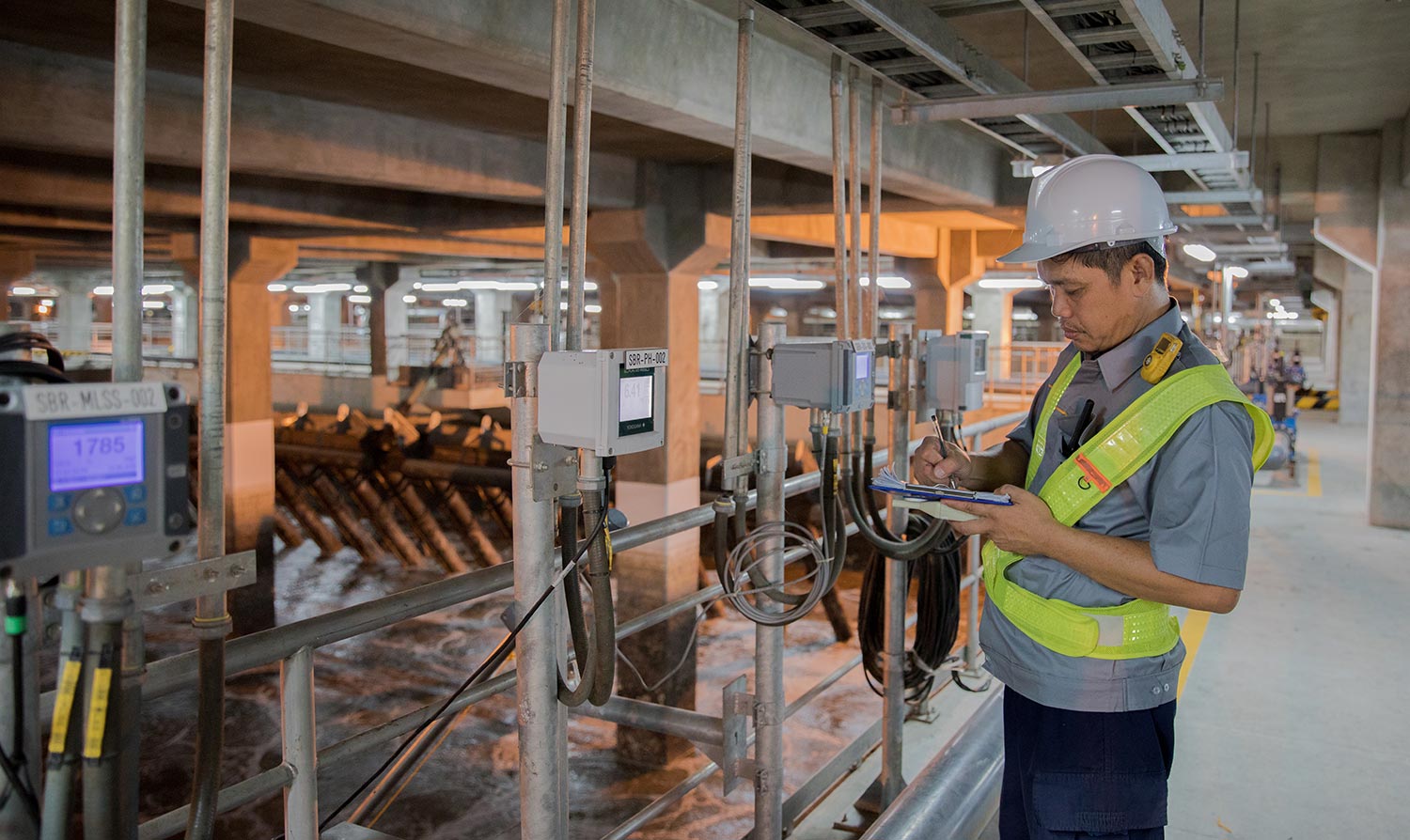
Manila Water utilizes energy efficient equipment and proactively maintains its equipment for optimum operations.
Manila Water enrolled qualified facilities to Meralco's Peak/Off-peak program, disconnected inactive facilities to Meralco, and used capacitor banks for power factor improvement resulting to cost reduction.
Energy Consumption
|
2019 |
2020 |
2021 |
|
Electricity, million kWh
|
244.87
|
275.32
|
271.93
|
|
Diesel, thousand Liters
|
1,132.65
|
1,513.41
|
1,691.39
|
|
Gasoline, thousand Liters
|
124.78
|
123.59
|
140.71
|
Energy Consumption, Gigajoules (GJ)
|
2019 |
2020 |
2021 |
|
Electricity
|
881,517
|
991,159
|
978,938
|
|
Diesel
|
43,833
|
58,202
|
65,457
|
|
Gasoline
|
4,342
|
4,301
|
4,897
|
|
Total
|
929,692
|
1,053,662
|
1,049,292
|
Energy Intensity
|
2019 |
2020 |
2021 |
|
Water Supply, GJ/MCM billed volume
|
987
|
1,180
|
1,175
|
|
Wastewater, GJ/MCM wastewater treated
|
1,663
|
1,353
|
1,463
|
|
2019 |
2020 |
2021 |
|
% grid electricity 1
|
94.7%
|
94.0%
|
88.6%
|
|
% renewable energy 2
|
0.1%
|
0.1%
|
4.7%
|
|
% fuel
|
5.2%
|
5.9%
|
6.7%
|
- 1 Percent grid electricity - grid, including open access non-renewable energy
- 2 Renewable energy includes on-site renewable energy generated; purchased through a renewable power purchase agreement but excludes the renewable portion of the electricity grid that is outside the influence of the company (as per SASB definition)

9,102 tons CO2e
reduced using renewable energy

13.63M kWh
total renewable energy was purchased in 2021 through East Zone and Cebu Water

156,800 kWh RE
generated from on-site solar panels

9.5 million kWh
reduced through energy efficiency initiatives
Reducing and Avoiding Carbon Emissions
Manila Water through its environmental initiatives contributes to the reduction and avoidance of greenhouse gas emissions. Reduction is achieved through the Company's energy efficiency initiatives and use of renewable energy. Carbon avoidance is achieved by treating wastewater aerobically in sewage treatment facilities, avoiding the emission of methane in septic tanks. The Company also helps in carbon capture through its watershed protection and reforestation efforts.
The Company is set to develop a roadmap for its net zero target aligned to 1.5 C temperature increase which will include reduction of Scopes 1, 2, and 3 in near-term and long-term horizons and carbon neutralization through wastewater treatment and forest carbon capture.
Commitment:
- 60% carbon reduced and avoided from energy efficiency, renewable energy, and wastewater treatment by 2025
- Continue watershed protection and reforestation in key watersheds that can contribute to carbon se capture
Strategies and Performance
Carbon Reduction
Aside from the energy efficiency initiatives implemented in each business unit discussed in the previous section, Manila Water harnesses renewable energy (RE) using onsite-solar panels in five facilities that generated 156,800 kWh RE. A total of 13.63 million kWh renewable energy was purchased in 2021 through East Zone and Cebu Water's purchase of 20% renewable energy in its Open Access electricity requirements starting mid-2021 and Thu Duc Water's purchased RE through a third-party provider. The use of RE reduced the Company's greenhouse gas emissions by 9,102 tons CO2e in 2021.
Greenhouse Gas Emissions, tons CO2e
|
2019 |
2020 |
2021 |
|
Scope 1 a
|
5,816
|
5,344
|
6,372
|
|
Scope 2 b
|
175,745
|
197,229
|
187,167
|
|
Scope 3 c
|
1,554
|
1,040
|
1,522
|
|
Total
|
182,781
|
203,467
|
195,061
|
a Scope 1 emissions are direct CO2 emissions from the use of fuel for vehicles, generator sets, and other equipment. Updated gasoline emission factor from 2.34 kg CO2e/L to 2.27 kg CO2e/L, the latest emission factor of GHG (Greenhouse Gas) Protocol.
b Scope 2 emissions are indirect CO2 emissions from the use of electricity of the Company. Scope 2 emission factor for Luzon and Visayas Grid (0.6836 kg CO2e/kWh, Mindanao grid (0.7859 kg CO2e/kWh) and Vietnam Grid (0.8795 kg CO2e/kWh) were based on the latest available National Grid Emission Factor.
c Scope 3 emissions are CO2 emissions from the desludging operations by contractors.
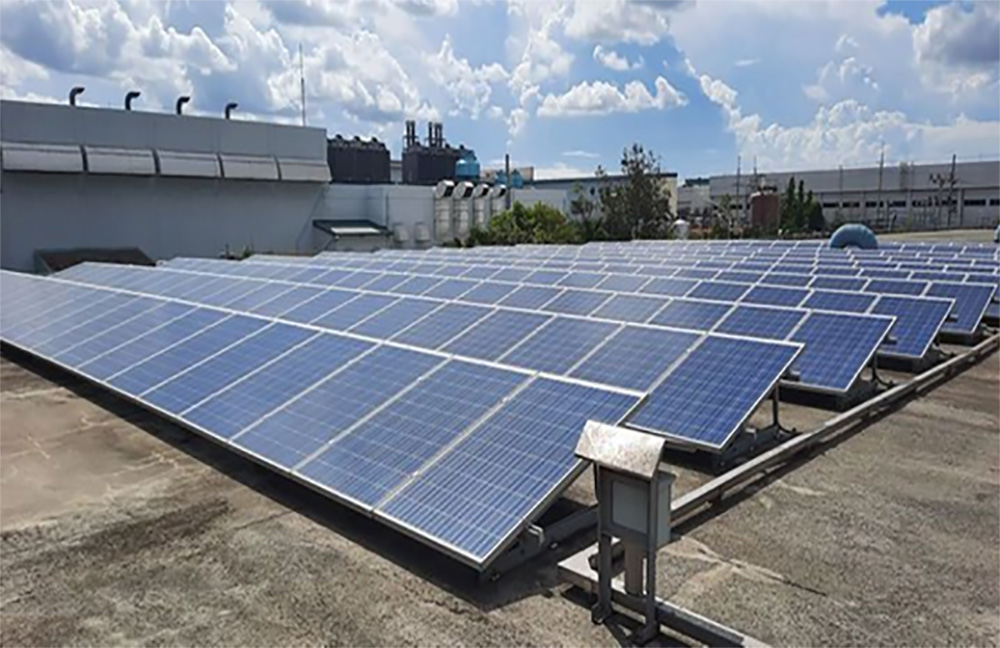
Laguna Water's onsite solar panels have a capacity of 57 kWp that provide clean energy and contribute to lower carbon emissions.
Carbon Avoidance and Carbon Capture
The wastewater sector is one of the focus areas of the Philippines Nationally Determined Contributions (NDCs) to the Paris Agreement that aims reduction and avoidance of greenhouse gas emissions of the country by 75% based on business as usual by 2030. The domestic wastewater sector's contribution is the expansion of their sewer and sanitation coverage to avoid methane emissions in septic tanks. Methane has 21x global warming potential compared to carbon dioxide. In 2021, Manila Water's wastewater treatment avoided 51,814 tons CO2e carbon emission.
The continuing watershed protection and reforestation program of Manila Water in its relevant watersheds help in nature-based carbon capture. The Company will commence Forest Carbon Accounting in the Ipo, Upper Marikina, and La Mesa Watersheds to determine the baseline and carbon capture rate in these watersheds. As of 2021, Manila Water has planted and nurtured 1,255,612 trees since 2006.
|
2019 |
2020 |
2021 |
|
Carbon dioxide avoided due to wastewater treatment, tons CO2e
|
79,085
|
74,030
|
51,814
|
Note: Computation of carbon dioxide avoided was based on the updated 2019 Intergovernmental Panel on Climate Change (IPCC) Guidelines for National Greenhouse Gas Inventories

1,255,612
trees planted and nurtured since 2019

51,814
carbon emission avoided through wastewater treatment
Ensuring Environmental Compliance
GRI 306-2, GRI 307-1
Manila Water takes a proactive approach in ensuring environmental compliance in every aspect of its undertaking. Manila Water had no significant environmental fines and penalties of more than PhP 50,000 nor non-monetary sanctions in 2021. The Company complies with standards and environmental requirements of regulatory bodies including the Department of Energy, Department of Health, Department of Environment and Natural Resources, National Water Regulatory Board, and Laguna Lake Development Authority.
Potential non-compliance is monitored frequently and acted upon to avoid adverse environmental impacts. Manila Water has Pollution Control Officers appointed for each facility who ensure compliance with all environmental regulatory requirements and whose performance is validated through regular internal audits. Waste minimization and pollution prevention are being implemented through operational control measures needed to address significant environmental aspects and impacts as identified in Hazard Identification, Risk Assessment, and Control (HIRAC) system.
To ensure that environmental and social impacts are addressed in a new environmentally critical project or project in an environmentally critical area, the Company performs an Environmental Impact Assessment and acquires an Environmental Compliance Certificate from DENR. The Company's environment unit and the Pollution Control Officers ensure that required permits are secured and up to date and reportorial requirements are submitted on time. To ensure compliance with all regulatory requirements of recently taken-over business units with inherent compliance matters, Manila Water made corrective measures and applied for the necessary permits.
Solid Waste Management
The largest contributor to nonhazardous solid wastes is wastewater treatment which converts organic pollution into microbial biomass in sludge, a by-product of aerobic treatment which further undergoes dewatering to yield biosolids. Biosolids from the East Zone Concession and Boracay Water facilities are hauled, composted, and used as a soil conditioner in laharaffected areas in Pampanga. Laguna Water composts biosolids within its treatment facility while Clark Water dries and stores biosolids in a drying pond in its wide expansive property. Grits and screenings from raw wastewater are properly disposed of in sanitary landfills. Other non-hazardous solid wastes generated in offices and facilities are segregated and disposed of properly. Recyclable materials are sold to junk shops while old meters are sold to recyclers.
Non-hazardous Waste Disposed, tons
|
2019 |
2020 |
2021 |
|
Biosolids
|
33,736
|
21,939
|
30,606
|
|
Grit and screenings
|
1,060
|
1,238
|
1,834
|
|
Total
|
34,796
|
23,177
|
32,440
|
|
2019 |
2020 |
2021 |
|
Hazardous Waste Generated, tons
|
27.72
|
133.04
|
63.18
|
Note: High hazardous wastes generation in 2020 due to a one-time disposal. The amount generated per type of HW is in the IR 2021 microsite's Environmental Performance Indices.
Hazardous Waste Management
Manila Water fully complies with the regulatory requirements set by DENR on hazardous waste management. The Company shifted to LED lighting, reducing the amount of busted fluorescent lamps generated yearon- year. In 2021, a total of 21.65 tons of hazardous waste were generated. Hazardous wastes are safely stored in hazardous wastes storage and properly transported, treated, and disposed of through DENR-accredited service providers.
Developing Environmental Advocates
Manila Water continuously engages its stakeholders in environmental and sustainability topics to promote environmental protection and sustainability. The Company's information, education, and communication during the pandemic shifted to digital platforms such as bulletins, social media, and online seminars.
Lakbayan Water Trail Tour, a longtime water education program and environmental advocacy of Manila Water to help raise awareness on the value of water and wise and mindful consumption of water, conducted 59 sessions with a total of 1,934 participants in 2021. Five module videos that contain learning taught during actual visits were developed for the Lakbayan online sessions.
The Toka Toka Movement is Manila Water's advocacy program that aims to inform and educate people on the need for wastewater management in communities, the value of personal commitment, and the collective impact of individual actions for the environment such as having septic tanks desludged, connecting houses to sewer lines where available, segregating solid waste and spreading the gospel of environmental sustainability among one's family and friends. In 2021, Manila Water recognized its Toka Toka partners from seven (7) National Government Agencies, five (5) private organizations, and 24 Local Government Units in its Gawad Katoka 2019, 2020 Achievers, and Toka Toka Awards 2021 for their support to the desludging initiatives of the Company.
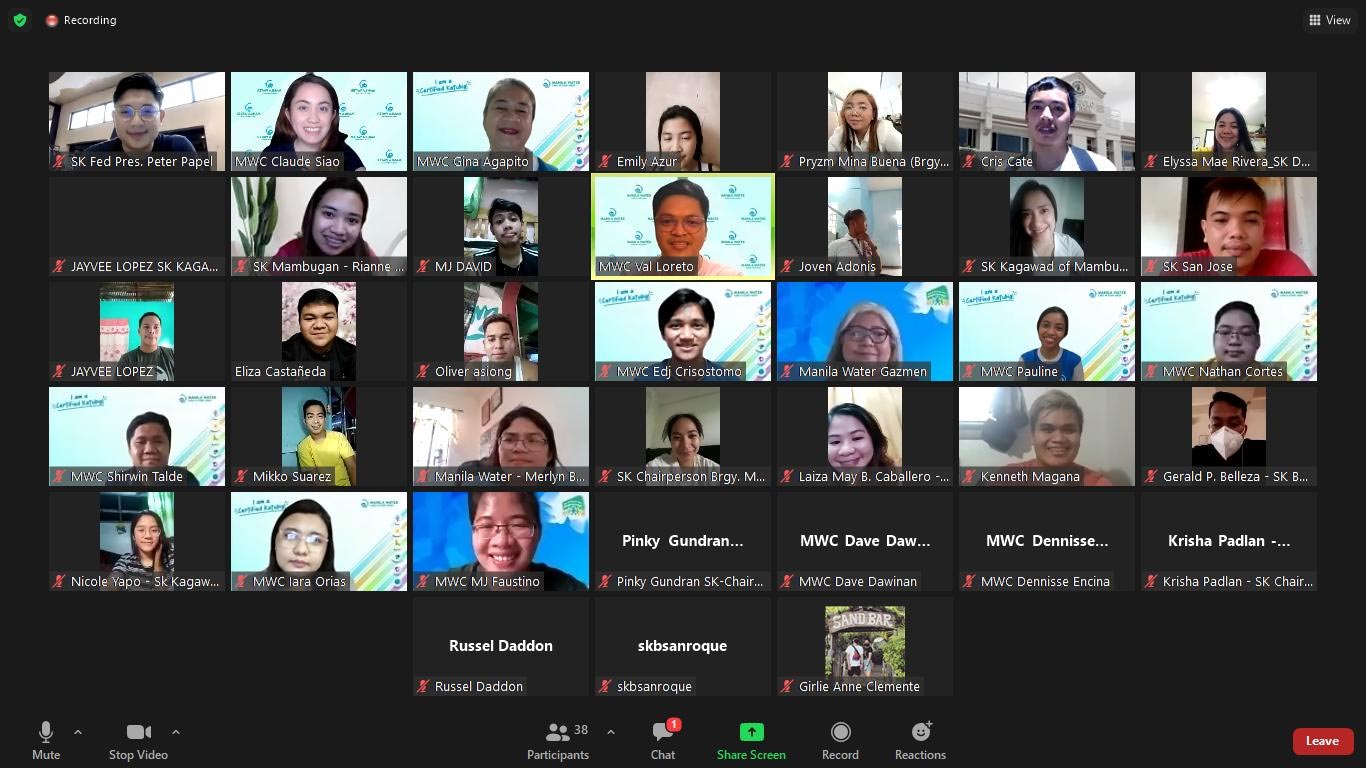
The Lakbayan online sessions continue to educate stakeholders on environmental protection during the COVID-19 pandemic.
In 2021, East Zone partnered with the DENR and several LGUs through a Memorandum of Agreement for the Adopt-an-Estero program to fully implement the cleanup and rehabilitation of San Juan River and its tributaries. Initiatives under the Adopt-an Estero Program include (1) monitoring of water quality of each adopted creeks, (2) a study to investigate the causes of stagnant water and technical solution and recommendation, (3) information and education campaign and river clean-up program (4) treatment of raw sewage from portable toilets and (5) desludging activities.
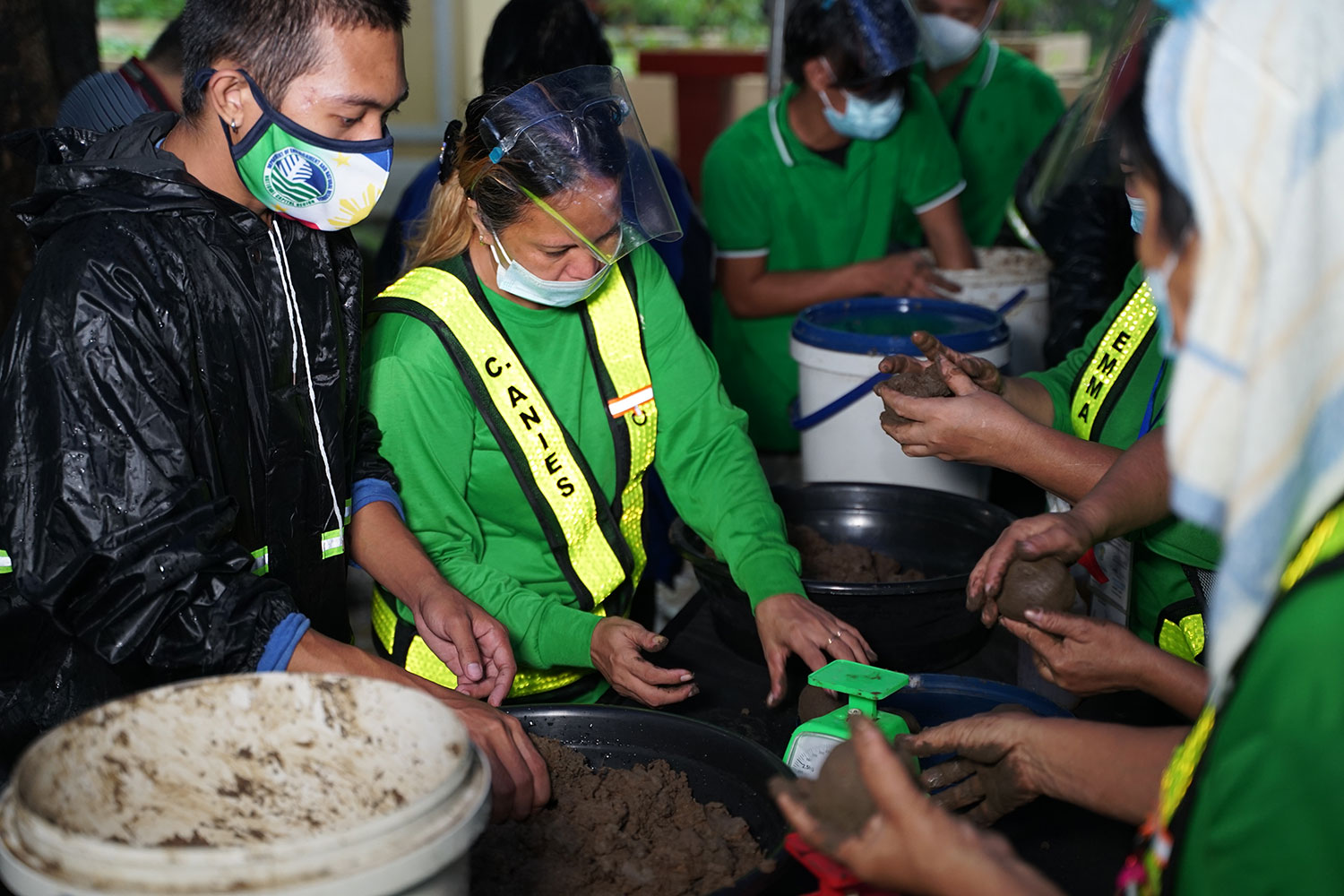
Community partners prepare Mabuhay balls that are infused with good microorganisms for the clean-up of the adopted creek in San Juan, Metro Manila.












